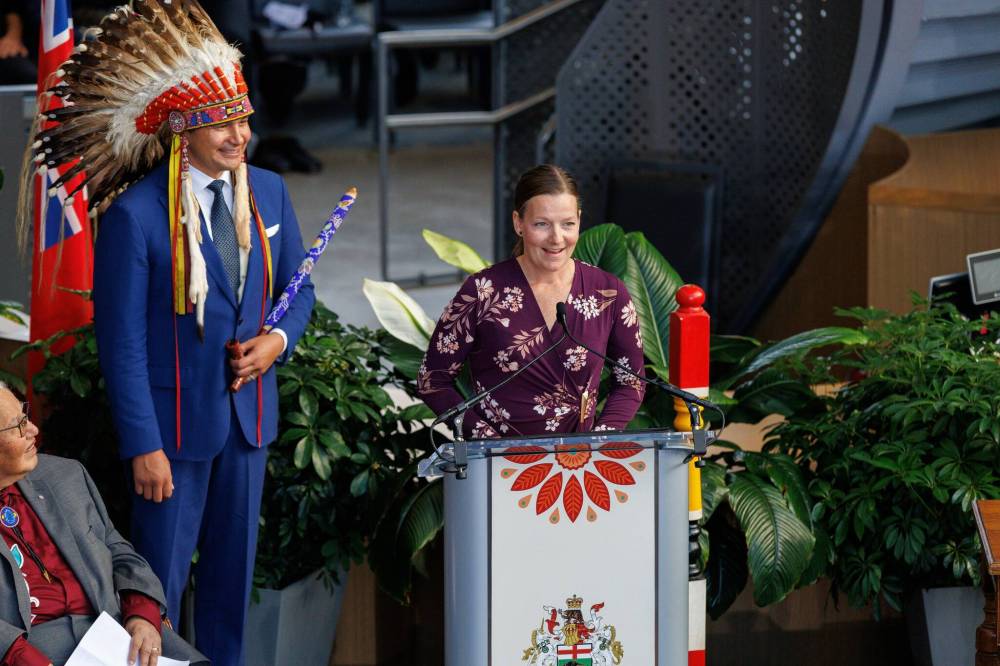
After four whirlwind weeks on the campaign trail chasing her first-ever seat in Manitoba’s legislature, newly-elected MLA Tracy Schmidt needed a little time to process.
She had just flipped Winnipeg’s Rossmere riding for the NDP as part of an orange wave across the province, and the people close to her suggested she take a moment to drink it all in.
So Schmidt grabbed her kayak and headed to the nearby Red River to spend a day on the water.
The labour lawyer, who had most recently been working for a Winnipeg public service union, decided to pursue politics in an effort to change the province’s trajectory and build a secure future — close to home — for her three young children.
MIKAELA MACKENZIE / WINNIPEG FREE PRESS files Tracy Schmidt, a first-time provincial political candidate, flipped the Rossmere riding to the NDP.
Weeks later, she would be appointed Manitoba’s new minister of Environment and Climate Change, inheriting a complex and important file that, despite a relative lack of experience with the issue, sits close to her heart.
“One of the reasons I love living in Manitoba is because of our natural environment,” Schmidt says, sitting in her new office.
A lifelong Manitoban, Schmidt has spent countless hours in the province’s wilderness. Growing up the child of two school teachers, her summers were spent traipsing the province’s campgrounds and provincial parks. She tries to inspire that same passion for her children, aged seven, 10 and 13.
On top of prioritizing regular camping trips (every weekend they can), day hikes and fishing expeditions, Schmidt is an avid canoeist and kayaker. For the last decade she’s also been a commuter cyclist — at least when there isn’t too much snow on the ground.
“I’m a proud Manitoban and I plan on spending the rest of my days here,” Schmidt says of her motivation for entering politics.
“It’s a real signal to Manitobans that they have elected a government that understands climate change, that believes in climate change and that takes it seriously and is willing to name it.”–Tracy Schmidt
“I hope my children stay close to me and also want to spend their lives in Manitoba, but I feared for the last several years under the mandate of the previous government that there was not a lot of opportunity being left here in Manitoba.”
Before her law career, Schmidt spent 10 years at Canada Post, taking part in several environmental initiatives spearheaded by the postal union.
The experience has provided her some background on climate issues, but it’s her legal expertise, she says, that likely earned her the climate post overseeing a host of interwoven legislation and regulations.
There’s a bit of a learning curve to the climate file, she admits, but she considers herself a lifelong learner (having gone back to law school as a 34-year-old mother in 2015) and more importantly she hopes to bring a fresh perspective to the file — one that isn’t in the business of mincing words about climate change.
“Climate change is an existential threat. I don’t think I’m overstating it when I state we’re facing a climate crisis,” Schmidt says.
“Our goals do have to be lofty and I think they have to be ambitious.”
Indeed the job comes with a lot of big asks. Her ministerial mandate letter, made public last week, outlines several “bold” commitments, including making Manitoba a “leader in clean energy,” following through on federal net-zero targets and conservation goals, protecting Lake Winnipeg and investing in provincial parks.
MIKE DEAL / WINNIPEG FREE PRESS files Schmidt takes the oath of office, becoming Minister of Environment and Climate Change, and minister responsible for Efficiency Manitoba.
For Schmidt, the most important task in the early days of her tenure will be to strike a balance between immediate action and “getting things right.”
Schmidt says her department will need to come to grips with a number of challenges left behind by the previous government, including the task of working within the confines of the existing budget — for now. The department suffered repeated funding and staffing cuts under Conservative party leadership, leaving fewer resources for services like environmental monitoring and enforcement.
What is clear to Schmidt, however, is the new provincial leadership wants to take climate issues seriously.
She is proud, for one, that the department was renamed to include the words “climate change” and not simply “climate.”
“You can’t you can’t fix a problem you don’t acknowledge,” Schmidt says.
“It’s a real signal to Manitobans that they have elected a government that understands climate change, that believes in climate change and that takes it seriously and is willing to name it.”
Is the department currently adequately resourced to meet the goals you’re pursuing? If not, what do you think needs to change?
One thing we’ve learned in this last couple of weeks, setting aside the issue of the cuts from the previous government which I think have been quite drastic, is the department is currently struggling with the vacancy rate in the positions that are left.
There is a very interesting labour market going on right now and we’ve heard a lot of challenges from within the department about the ability to recruit and retain staff.
That’s something else I bring to the portfolio right away is my background as a worker representative and as someone who has worked in the labour movement for the last 10 years — I recognize the value of our human resources.
The general theme across government has been a slash-and-burn mandate in the public service. We’re heading into our next budget process, obviously we’re currently working within the last budget, and we’re going to be working very closely with our financial staff to make sure the resources in the department align with the priorities of our government.
As part of reversing the Tory legacy, Schmidt says her department has re-assumed responsibility for the parks and trails branch — which had been shuffled into the Natural Resources portfolio late in the previous government’s tenure — and her priorities include “protecting them, improving them and keeping them public.”
Of top priority for Schmidt in the coming months is to start work towards conservation targets the NDP committed to during the campaign. Namely, the 30-by-30 targets established by the United Nations, which call on governments to protect 30 per cent of their lands and waters from development by 2030.
To date, Manitoba has protected about 11 per cent of its land area, leaving a lot of work to do (about 140,000 square kilometres worth) in the next six years.
Manitoba’s parks have become an arena for conservation debates in recent years as the resource extraction sector quietly pressed government to allow prospecting in all corners of the province — including parks — and advocated for the suspension of all protected areas.
How do you plan to move towards conservation goals while balancing so many stakeholder interests?
Our government, I believe, is taking a balanced approach. Certainly we have a mind to those challenges, but it’s a very important goal. It’s one that if we don’t think about it seriously, we are not going to meet our emissions targets.
We come at it from a perspective that we really are a government that wants to work for everybody, we’re not here to represent one community or another, we’re here to work in the best interest of all Manitobans.
I really look forward to working with industry to find a way we can do this that prioritizes environmental protection but also contributes to a robust economy here in Manitoba.
For Schmidt, conservation targets are non-negotiable, both for the sake of the land itself, but also in pursuit of one of the new government’s central philosophies: “making strides towards meaningful reconciliation in the province.”
“I don’t think there’s a way to move forward on protecting 30 per cent of our lands without working really closely and in partnership with Indigenous nations in Manitoba,” she adds.
There are currently a handful of Indigenous Protected and Conserved Area proposals in development across Manitoba, most notably the Seal River Watershed Alliance, which has proposed a 50,000-square-kilometre conservation area stewarded by local land guardians to protect the province’s only undammed river and the thousands of barren ground caribou, beluga whales and other species that call the Seal River home.
The Seal River protected area alone would protect nearly eight per cent of the province, while seven other proposed Indigenous protected areas could safeguard another 10 per cent of the province.
What does it look like for you to engage Indigenous communities in the environment portfolio and in the conservation portfolio?
I hope I’m not speaking too boldly here — I don’t think I am — our government is committed to move beyond the standard requirements right now, [which] are for meaningful consultation with Indigenous communities.
It is time we move a step beyond that, towards more of a consent model. Exactly what that looks like, to be frank, I don’t know.
I think the goals of First Nations in our province align with the goals of our government and in fact align with the goals of all Manitobans, which is having a robust economy where we can all thrive, but the economy can’t thrive whatsoever without a clean environment.
Climate change is a huge threat, not only to our existence, but before that to our economy. So I don’t think it’s necessarily one versus the other.
I think there’s a way of advancing our environmental goals with our economic interests, and the best way to do that is in partnership with Indigenous First Nations. They have been the protectors and the stewards of our land and waters for thousands of years prior to colonialism, so there’s a lot of lessons to be learned there.
The Seal River Alliance in particular has had some holdups at the provincial government level. Where do you stand on that? Are you throwing your support behind them?
As the Minister, I have not yet had an opportunity to engage directly with that group or with some of the other stakeholders involved so I just feel personally it would be a bit premature for me to offer a strong opinion either way.
I understand they’re doing excellent work. There are a lot of environmental protections needed up there.
There have been some very high priority files [that have] come across our desk in the last couple of weeks; that is a very high priority, but not one I feel like I’m educated enough to be able to give a really great answer.
The most pressing file on Schmidt’s desk, she says, has been Sio Silica, the highly controversial proposal for a silica sand mining operation in a freshwater aquifer serving thousands of southeastern Manitoba residents.
The proposal was referred to Manitoba’s Clean Environment Commission last year after a wave of public concern the project would devastate the region’s drinking water source. The commission compiled a report after weeks of hearings, which outlined unaddressed risks associated with the mining proposal.
The previous environment minister passed that report to a committee of technical experts to make recommendations for an environmental licence. Schmidt says she has had “daily briefings digging down through the project one level at a time,” but has not yet met with the technical advisory committee.
Do you have a stance you can share on the Sio Silica project?
It’s a very, very important decision. It’s a very novel project here in Manitoba. There’s a lot of opportunity on the other side of the project, however, there is a sufficient degree of risk.
There’s a lot of opportunity, a lot of risk, and my priority right now is really taking my time. I don’t think we need to rush into this decision, in fact I think it would be the absolute wrong thing to do.
The department has been doing a lot of great work on the file already, the Clean Environment Commission certainly did a lot of great work in their analysis, but there’s further work to be done in my opinion. There’s a lot at stake.
The environmental issue dominating the headlines of late, however, has been the future of Manitoba Hydro, as the utility grapples with the uncertainty of a looming energy transition.
Schmidt’s portfolio includes responsibility for Efficiency Manitoba — the government arm in charge of cutting back on provincial energy use — and the minister has been tasked with helping guide Manitoba towards net-zero emissions targets.
The province aims to have an emission-free power grid by 2035 and to achieve net-zero emissions province-wide by 2050, in line with national targets.
At the same time, the government is juggling affordability concerns stemming, at least in part, from the cost of fossil fuels. That mix of responsibilities has generated some mixed messaging from ministers, the premier and Manitoba Hydro about the direction the province will take in its pursuit of both affordability and environmental responsibility.
During the campaign, the NDP committed to electric vehicle rebates and a subsidized geothermal home heating program as part of the push towards decarbonization. Premier Wab Kinew has publicly suggested the days of new hydroelectric dam production are over, touting instead the possibility of developing green hydrogen technology.
Manitoba Hydro has sounded the alarm that demand for electric power will soon outstrip grid capacity, noting hydrogen production would seriously strain existing resources and indicating the most cost-effective, near-term solution would be to invest in natural gas production. Kinew has said new natural gas plants are not part of his plan.
What energy options you and your colleagues are considering?
Manitoba has done a lot of great things, but we’ve also lagged behind many other provincial jurisdictions when it comes to cutting our emissions at the same rate — including jurisdictions that have a lot of hydroelectric power in the same way we do.
There are some provinces already outperforming us, and a large reason is they’ve heavily pursued electrification in transportation.
We have some great ideas about an electric-vehicle rebate program to encourage and assist Manitobans in making that choice, however, as we know, that will require we put a burden on our grid.
That’s where we have other exciting proposals such as the geothermal program: we plan on ramping up geothermal participation by the use of our affordable energy program, which our plan is to administer through Efficiency Manitoba.
If we can get up to 5,000 Manitoba homes and families off the grid, that will not only free up some important space on our energy grid, but also hopefully make life a lot more affordable for those families.
I’m excited about developing our hydrogen production capabilities here in Manitoba, which will again require some room on the grid.
There’s certainly a balancing act. Right now, what’s important is that, as I said the other day, all options are on the table.
When you say everything is on the table, does that include natural gas?
I know it’s certainly not high on our priority list. We’re really looking to reduce emissions. But the responsible answer today is nothing is off the table.
We’re looking for green technologies, we’re looking for progress, we’re not really looking to go back to some of those old fossil fuel industries. We’ve got ambitious priorities, we’ve got ambitious goals and we’ve got to find a way to reach them.
Nothing is off the table, but there are certainly some plans that are less attractive than others.
It’s really hard to talk about energy and affordability in Manitoba without talking about carbon pricing. Where does your office stand?
I don’t believe our government thinks the carbon tax is a panacea or the solution to the problem. Carbon pricing is a tool in the toolbox.
We are seeing some benefits from carbon pricing. There certainly is rightly some criticism.
I don’t think the previous government’s suggestion they were going to take the feds back to court was a good one — I think I’m safe in saying that — and I think I’m safe in saying that’s not the direction our province is going in. We are not here to fight with the federal government.
Whether it’s the city, municipalities, Indigenous Nations or the federal government, we are really here to work in partnership and to find real solutions that are going to work for Canadians and reduce our greenhouse gas emissions globally.
But that also recognizes affordability is a real challenge here in Manitoba and across Canada, there are certainly inflationary pressures, but as I said earlier: we don’t have an economy without a clean environment.
This conversation has been edited for length and clarity.
Julia-Simone Rutgers
Reporter
Julia-Simone Rutgers is a climate reporter with a focus on environmental issues in Manitoba. Her position is part of a three-year partnership between the Winnipeg Free Press and The Narwhal, funded by the Winnipeg Foundation.
Read full biography


